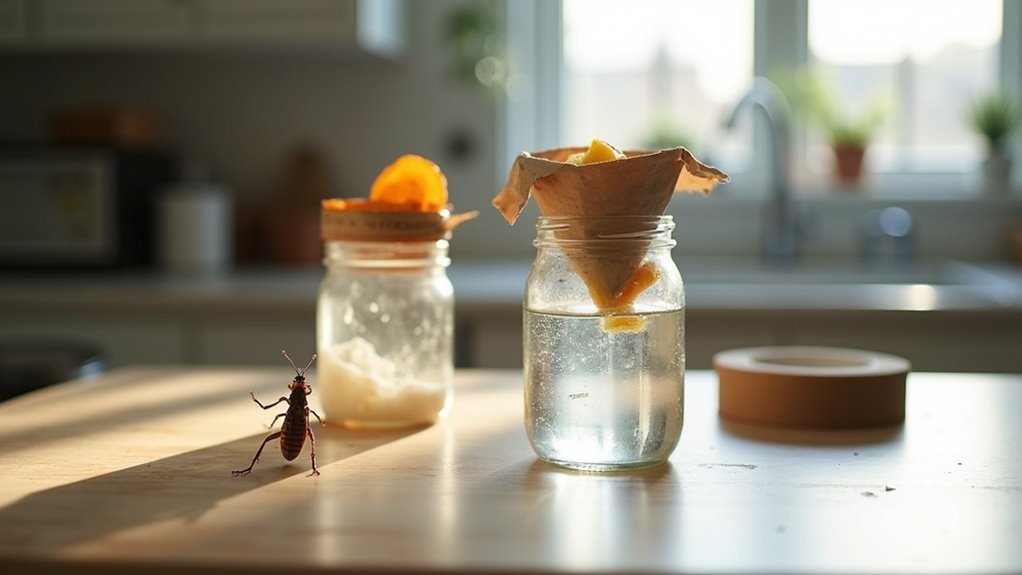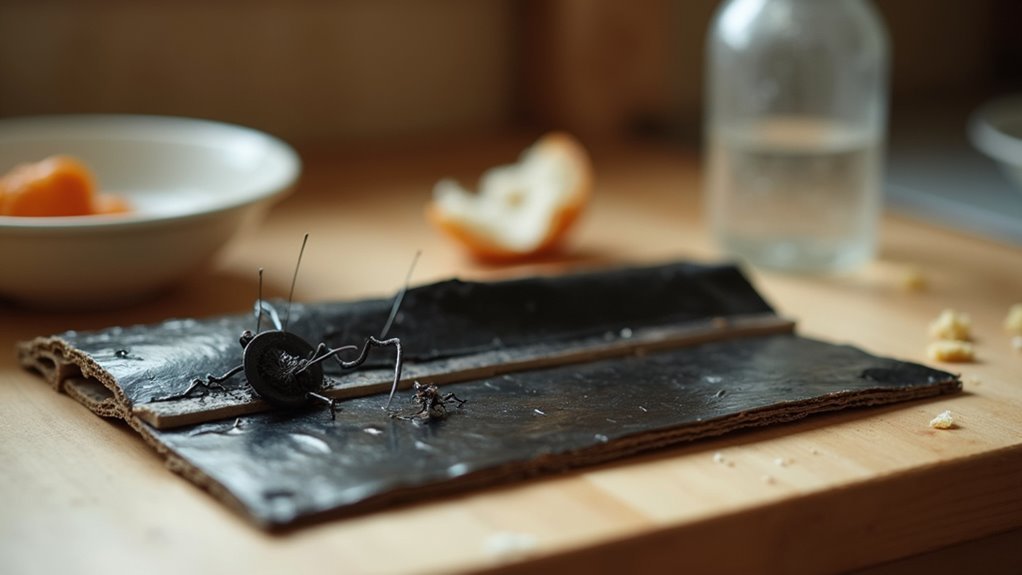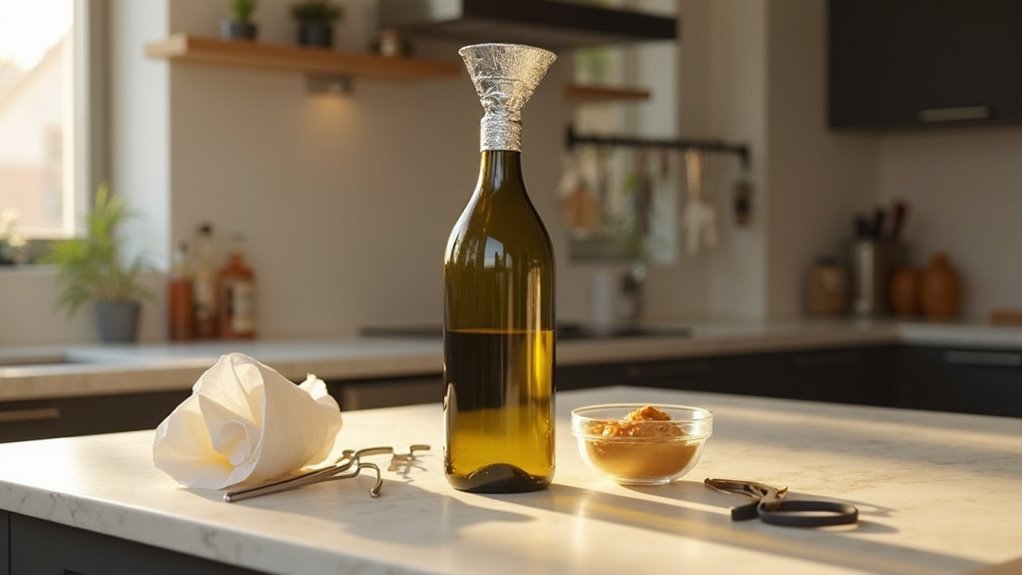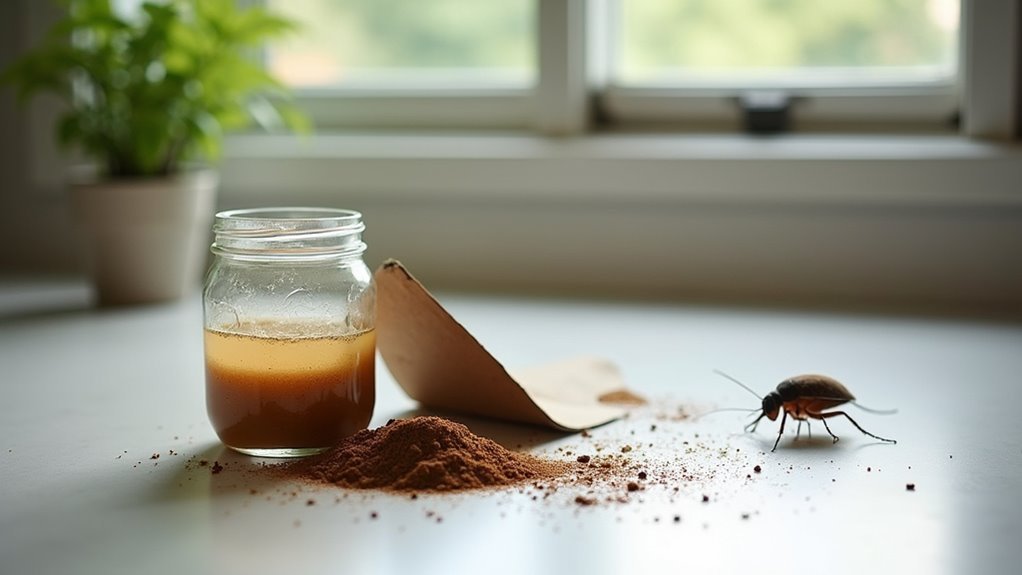You can easily build effective roach traps using common household items like duct tape, glass jars, and plastic bottles. Create sticky traps by placing duct tape adhesive-side up in dark corners, or make jar traps by coating the inside rim with petroleum jelly and adding sweet bait like honey or overripe fruit. Position these traps behind appliances and in damp areas where roaches commonly travel. Check and replace bait every few days for maximum effectiveness, and you’ll discover additional advanced techniques below.
Understanding Cockroach Behavior and Entry Points

Before you can effectively trap cockroaches, you must understand how these persistent pests operate and where they’re likely to enter your home.
These nocturnal creatures slip through tiny openings, gaps around doors and windows, and damaged exterior surfaces. When you inspect your home, focus on areas where roaches commonly hide: dark, damp spaces under cabinets, appliances, and furniture in kitchens and bathrooms where food and moisture attract them.
German cockroaches, the most common species, thrive in human environments and breed rapidly—females produce up to 400 offspring during their lifetime.
In apartments, they’ll migrate between units through shared vents and drains. Understanding these entry patterns helps you position traps strategically for maximum control effectiveness.
Essential Materials for DIY Roach Traps
The beauty of DIY roach traps lies in their simplicity—you can create effective pest control solutions using materials you likely already have at home.
Essential materials for DIY roach traps include duct tape, glass jars, plastic bottles, and petroleum jelly. You’ll need fresh, sticky duct tape for adhesive traps, while jars require petroleum jelly coating their interior walls to prevent escape.
Tall, narrow-mouthed bottles work excellently as bait stations when their surfaces become slippery. Sweet baits like honey, sugar, overripe fruit, or wine attract roaches effectively.
These common household items transform into powerful weapons against cockroach infestation. The key is combining the right container with proper bait placement in high-traffic areas where roaches frequently travel.
Duct Tape Sticky Trap Method

Starting with the simplest approach, duct tape offers an incredibly straightforward method for creating effective roach traps. You’ll place fresh duct tape sticky side up in areas where cockroaches frequently travel.
| Step | Action |
|---|---|
| 1 | Lay duct tape sticky side up |
| 2 | Add bait like banana peels or onion |
| 3 | Tuck edges under for secure placement |
| 4 | Check traps overnight |
Position your bait directly in the center of the tape to draw cockroaches toward the sticky surface. Sweet or oily substances work best as attractants. Tuck the tape’s edges underneath to prevent movement when roaches approach the sticky trap. Check your traps each morning to assess effectiveness, then replace the tape and bait regularly to maintain peak performance.
Mason Jar Petroleum Jelly Trap
You’ll need just a few simple items to create this effective roach trap using a quart-size mason jar.
The setup involves coating the jar’s interior with petroleum jelly and wrapping the outside with sticky tape for better grip.
Strategic placement in dark, enclosed areas where roaches frequent will maximize your trap’s success rate.
Materials and Setup
Building this petroleum jelly trap requires only four basic materials: a quart-size mason jar, petroleum jelly, sticky tape, and attractive bait.
Begin by coating the jar’s interior walls with a generous layer of petroleum jelly, creating a slippery barrier that prevents cockroaches from climbing out once they’ve entered your Mason jar trap.
Next, bait the jar with enticing food like overripe fruit or beer, placing it at the bottom to lure roaches inside.
Wrap sticky tape around the jar’s exterior surface, providing necessary traction for cockroaches to climb up and fall in.
Position your completed trap in dark corners or areas where you’ve spotted roach activity.
Once you’ve caught cockroaches, dispose of them by pouring boiling water into the jar before discarding.
Placement and Effectiveness
When you’ve finished assembling your mason jar trap, strategic placement becomes essential for maximizing its effectiveness. Position your trap in enclosed spaces where you’ve frequently spotted cockroaches, as they prefer dark, hidden locations. This targeted placement approach can rival professional pest control service results when executed properly.
Consider these ideal placement locations:
- Behind kitchen appliances where moisture accumulates and crumbs gather
- Under bathroom sinks near plumbing where roaches seek water sources
- In pantry corners behind stored food containers and boxes
- Along baseboards in laundry rooms where warmth attracts pests
Ensure traps remain beyond the reach of pets and children.
Monitor your traps over several nights to assess effectiveness. When you’ve captured roaches, dispose of them immediately using boiling water for quick elimination.
Wine Bottle Funnel Trap Design

You’ll need a tall, narrow-mouthed bottle and should coat the interior with cooking oil or petroleum jelly to create a slippery escape-proof surface.
Use overripe fruit or mix dry red wine with a quarter teaspoon of sugar as bait to attract roaches into your trap.
Place these traps in dark corners and near compost heaps where cockroaches commonly hide for maximum effectiveness.
Bottle Preparation Steps
Start by leaving a few teaspoons of wine inside the bottle to attract cockroaches with its sweet aroma.
These bottle preparation steps guarantee maximum effectiveness for your homemade trap.
Follow these essential preparation techniques:
- Place bait strategically – Add a quarter teaspoon of sugar to dry red wine, or create a sugar-water mixture with boiled fruit to prevent mold formation.
- Create escape barriers – Smear cooking oil or petroleum jelly around the inside of the jar’s neck area for slippery surfaces.
- Position near water sources – Set traps in dark corners, under sinks, or areas where roaches seek moisture.
- Monitor regularly – Check traps nightly for several days, adjusting bait quantity or relocating as needed.
These preparation steps transform ordinary wine bottles into effective cockroach elimination tools.
Wine Bait Effectiveness
Although many household items can serve as cockroach bait, wine’s fermented sugars create an irresistible attraction that outperforms most alternatives. The sweet aroma draws roaches from considerable distances, making your trap markedly more effective than using simple food scraps or sugary liquids.
The fermentation process enhances wine’s attractiveness over time, so you don’t need to worry about immediate replacement. This natural aging actually improves the bait’s potency, creating stronger scents that roaches can’t resist.
You’ll only need a few teaspoons of wine per trap to achieve ideal results. The concentrated sugars work continuously, maintaining their appeal for several days.
This efficiency makes wine an economical choice for long-term roach control, especially when targeting multiple areas simultaneously.
Trap Placement Strategy
Where should you position your wine bottle funnel trap for maximum roach capture? Your trap placement strategy determines success, so target common hiding spots where cockroaches naturally congregate and travel.
Position traps in these strategic locations:
- Dark corners behind appliances – refrigerators, stoves, and dishwashers create warm, hidden environments.
- Under kitchen sinks – moisture and food residue attract cockroaches to plumbing areas.
- Near garbage bins – food waste creates irresistible scent trails leading roaches directly to traps.
- Along baseboards in bathrooms – humidity and standing water draw roaches seeking moisture.
Create spilled wine trails leading toward your traps to attract cockroaches more effectively.
Monitor the trap nightly, checking which locations yield the best results. If you’re not catching roaches within three days, relocate traps to different areas until you find their preferred pathways.
Trap Placement and Disposal Best Practices
Once you’ve constructed your roach traps, strategic placement becomes essential for maximizing their effectiveness. Position traps in high-traffic areas like kitchens, bathrooms, and dark corners behind appliances where cockroaches commonly gather.
Make certain your trap placement is secure to prevent tipping, as roaches avoid unstable traps.
Monitor traps regularly and replace bait every few days since roaches quickly lose interest in stale offerings. Consider experimenting with different bait types across multiple locations to determine which proves most effective for your specific infestation.
When it’s time to dispose of captured roaches, pour boiling water into the trap or seal it completely before discarding in outdoor trash. This prevents potential escapes and makes certain proper elimination of the captured pests.
Frequently Asked Questions
How Do You Make a Homemade Roach Trap?
You’ll create effective roach traps using duct tape placed sticky-side up with bait, glass jars lined with petroleum jelly, or cut soda bottles inverted into funnels with attractants inside.
What Household Item Keeps Roaches Away?
You can use peppermint oil spray around entry points, sprinkle baking soda mixed with sugar, clean surfaces with vinegar, apply diatomaceous earth powder, or place citrus peels where roaches commonly appear.
What Is the Best Homemade Roach Killer?
You’ll get the best results mixing boric acid with flour and honey or Karo syrup. This combination attracts roaches while the boric acid disrupts their digestive systems, effectively killing them.
How to Attract a Cockroach Out of Hiding DIY?
You’ll attract cockroaches using sweet baits like peanut butter or honey. Place these near their hiding spots under sinks and appliances. Create sugar water trails leading to your traps for maximum effectiveness.
In Summary
You’ve now learned several effective methods to create roach traps using common household items. Remember that trap placement matters more than trap design—position them near entry points and dark corners where you’ve spotted activity. Don’t expect overnight results; it’ll take several days to see significant reduction. Replace traps regularly and combine these methods with proper sanitation for the best long-term cockroach control in your home.





Leave a Reply